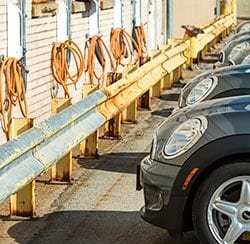What would happen if an Australian shopping centre car park needed to host one thousand EVs all looking for a quick recharge at the same time on a hot summer’s day?
According to a new white paper by NOJA Power, it’s a scenario that could quite easily become a reality in just a few years’ time. And without some major enhancements to Australia’s network capabilities, and its renewable energy capacity, it’s a scenario that could easily enough tip our electricity grid over the edge.
Today, EVs only represent a small fraction of Australia’s vehicle fleet – a total of just 253 EVs were sold nationwide during 2012. But according to industry predictions, rising fossil fuel costs and the need to cut greenhouse gas emissions is likely to see this number increase to one million EVs on Australian highways by 2022.
Australian utilities, meanwhile, generated 227TWh of electricity in 2010 – or around 622 GWh per day. And according to the NOJA white paper, a fleet of one million EVs would require about an additional 4.8 per cent on top of this daily total to recharge its batteries.
But as the NOJA white paper points out, this could be a tall order for the Australian grid in its current state, with very little spare capacity at times of peak demand. Which brings us back to the problem of what happens when you add 1000-odd EVs plugging in one place at one time, on a hot summer’s day?
“I can picture a scenario where on a hot day in Queensland, Australia, in the near future a shopping centre car park is hosting one thousand EVs all looking for a quick recharge before returning home,” says Neil O’Sullivan, Managing Director of NOJA Power.
“Commercial charging points are likely to offer 415 volt/32 amp three-phase power allowing each EV to receive up to 13.2 kilowatts. That’s 13.2 megawatts just for that one car park. And those vehicles could be taking power for perhaps an hour or two.
“There are three million vehicles in Queensland. If, for example, in the near future, 10 per cent of those are EVs and a quarter of those EVs are simultaneously being quick charged across the state the utilities could see nearly 1000 megawatts of additional demand,” says O’Sullivan. “The peak demand seen in Queensland is around 8900MW, so an additional 1000MW is easily enough to tip the grid over the edge if it occurs at the wrong time.”
To avoid such future scenarios, NOJA says, we will need to invest in smart grid technologies – and in particular, smart grids equipped with automatic circuit reclosers (ACRs), which would allow the connection to the large installed base of renewable energy sources that would be needed to ensure EVs could deliver on their low-carbon promise.
“ACRs are fundamental building blocks for smart grids,” says O’Sullivan. “The ability of reclosers to help utilities closely match supply and demand, rapidly switch in renewable energy sources and protect the grid is essential if the future additional demand from EVs is to met.”
According to the paper, the units allow utilities to control and monitor renewable energy connections to the electrical grid while at the same time protecting valuable renewable energy assets. ACRs can also help to balance peak loads through control of renewable or storage energy into or out of the grid.
A smart grid provides sufficient flexibility for utilities to tap into diverse sources of renewable power – including co-generation facilities from large customers – at relatively short notice, maximising the EV’s carbon emission reductions, says the paper.











